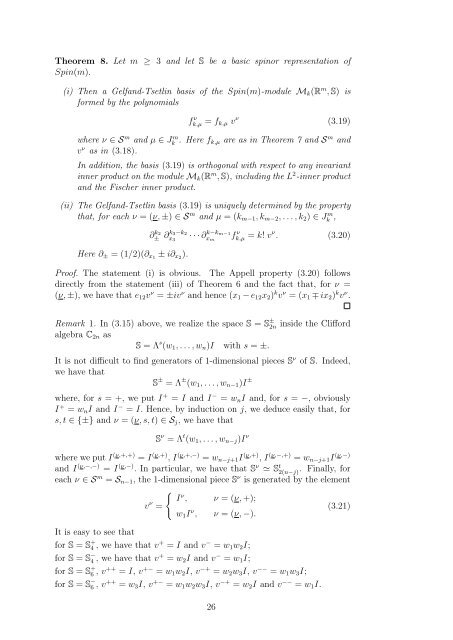Hypercomplex Analysis Selected Topics
Hypercomplex Analysis Selected Topics
Hypercomplex Analysis Selected Topics
You also want an ePaper? Increase the reach of your titles
YUMPU automatically turns print PDFs into web optimized ePapers that Google loves.
Theorem 8. Let m ≥ 3 and let S be a basic spinor representation of<br />
Spin(m).<br />
(i) Then a Gelfand-Tsetlin basis of the Spin(m)-module Mk(R m , S) is<br />
formed by the polynomials<br />
f ν k,µ = fk,µ v ν<br />
(3.19)<br />
where ν ∈ S m and µ ∈ J m k . Here fk,µ are as in Theorem 7 and S m and<br />
v ν as in (3.18).<br />
In addition, the basis (3.19) is orthogonal with respect to any invariant<br />
inner product on the module Mk(R m , S), including the L 2 -inner product<br />
and the Fischer inner product.<br />
(ii) The Gelfand-Tsetlin basis (3.19) is uniquely determined by the property<br />
that, for each ν = (ν, ±) ∈ S m and µ = (km−1, km−2, . . . , k2) ∈ J m k ,<br />
Here ∂± = (1/2)(∂x1 ± i∂x2).<br />
∂ k2<br />
± ∂ k3−k2<br />
x3 · · · ∂ k−km−1<br />
xm f ν k,µ = k! v ν . (3.20)<br />
Proof. The statement (i) is obvious. The Appell property (3.20) follows<br />
directly from the statement (iii) of Theorem 6 and the fact that, for ν =<br />
(ν, ±), we have that e12v ν = ±iv ν and hence (x1 − e12x2) k v ν = (x1 ∓ ix2) k v ν .<br />
Remark 1. In (3.15) above, we realize the space S = S ± 2n inside the Clifford<br />
algebra C2n as<br />
S = Λ s (w1, . . . , wn)I with s = ±.<br />
It is not difficult to find generators of 1-dimensional pieces S ν of S. Indeed,<br />
we have that<br />
S ± = Λ ± (w1, . . . , wn−1)I ±<br />
where, for s = +, we put I + = I and I − = wnI and, for s = −, obviously<br />
I + = wnI and I − = I. Hence, by induction on j, we deduce easily that, for<br />
s, t ∈ {±} and ν = (ν, s, t) ∈ Sj, we have that<br />
S ν = Λ t (w1, . . . , wn−j)I ν<br />
where we put I (ν,+,+) = I (ν,+) , I (ν,+,−) = wn−j+1I (ν,+) , I (ν,−,+) = wn−j+1I (ν,−)<br />
and I (ν,−,−) = I (ν,−) . In particular, we have that Sν St 2(n−j) . Finally, for<br />
each ν ∈ Sm = Sn−1, the 1-dimensional piece Sν is generated by the element<br />
v ν <br />
ν I ,<br />
=<br />
w1I<br />
ν = (ν, +);<br />
ν , ν = (ν, −).<br />
(3.21)<br />
It is easy to see that<br />
for S = S + 4 , we have that v + = I and v − = w1w2I;<br />
for S = S − 4 , we have that v + = w2I and v − = w1I;<br />
for S = S + 6 , v ++ = I, v +− = w1w2I, v −+ = w2w3I, v −− = w1w3I;<br />
for S = S − 6 , v ++ = w3I, v +− = w1w2w3I, v −+ = w2I and v −− = w1I.<br />
26

















